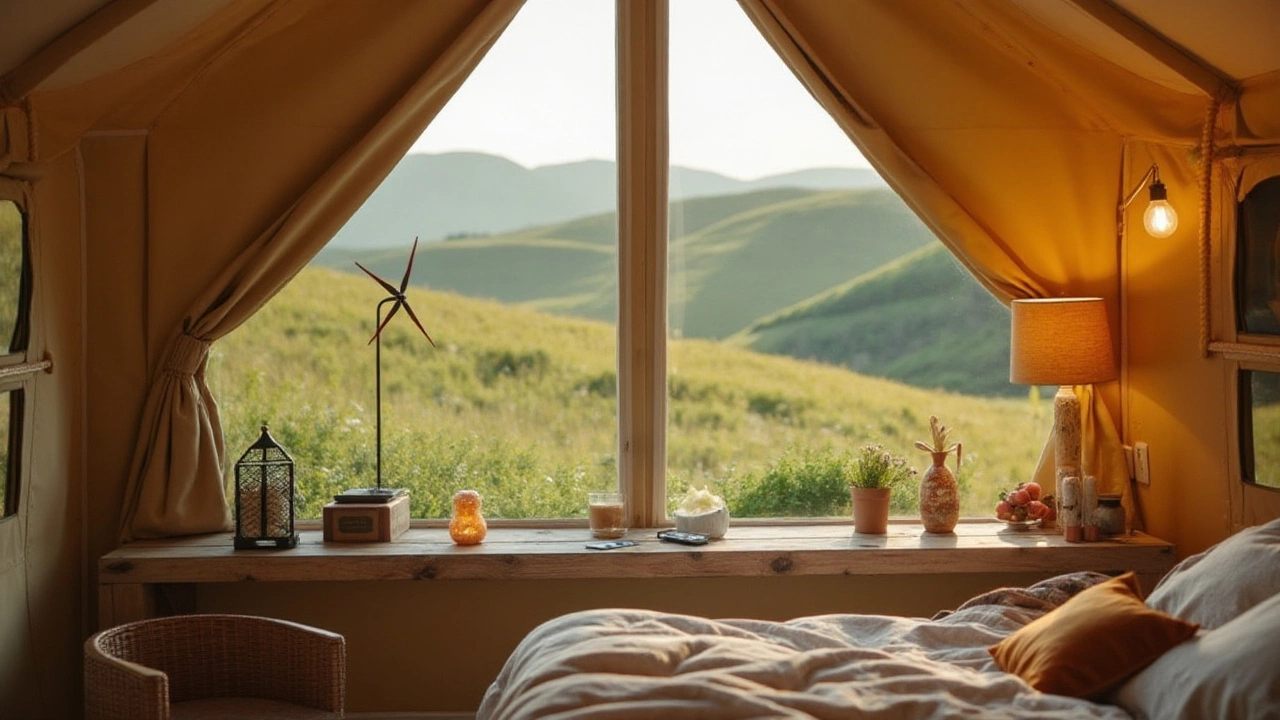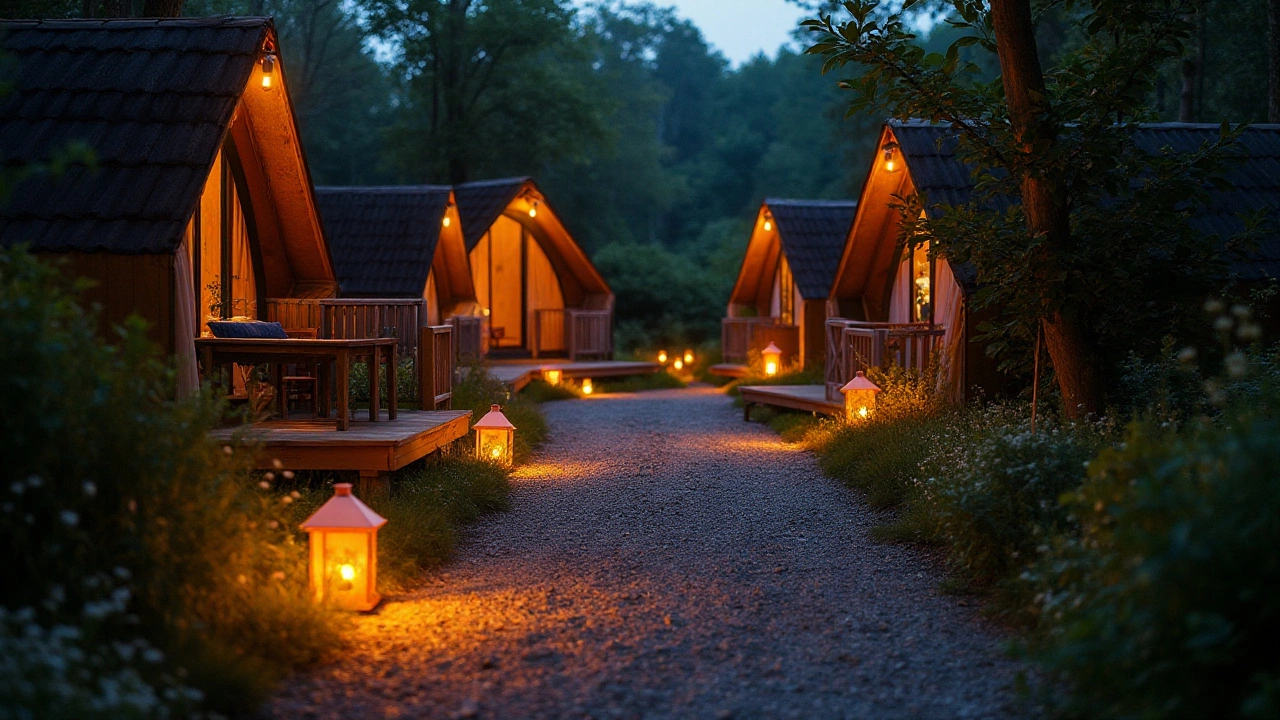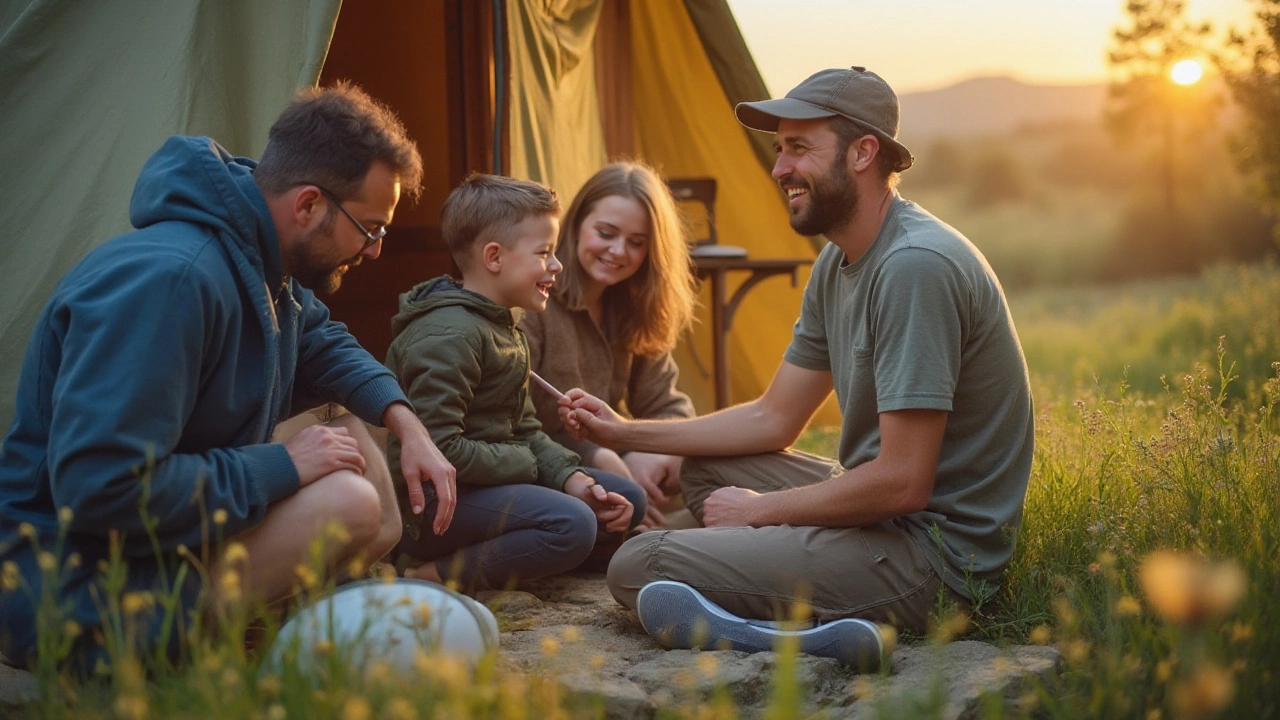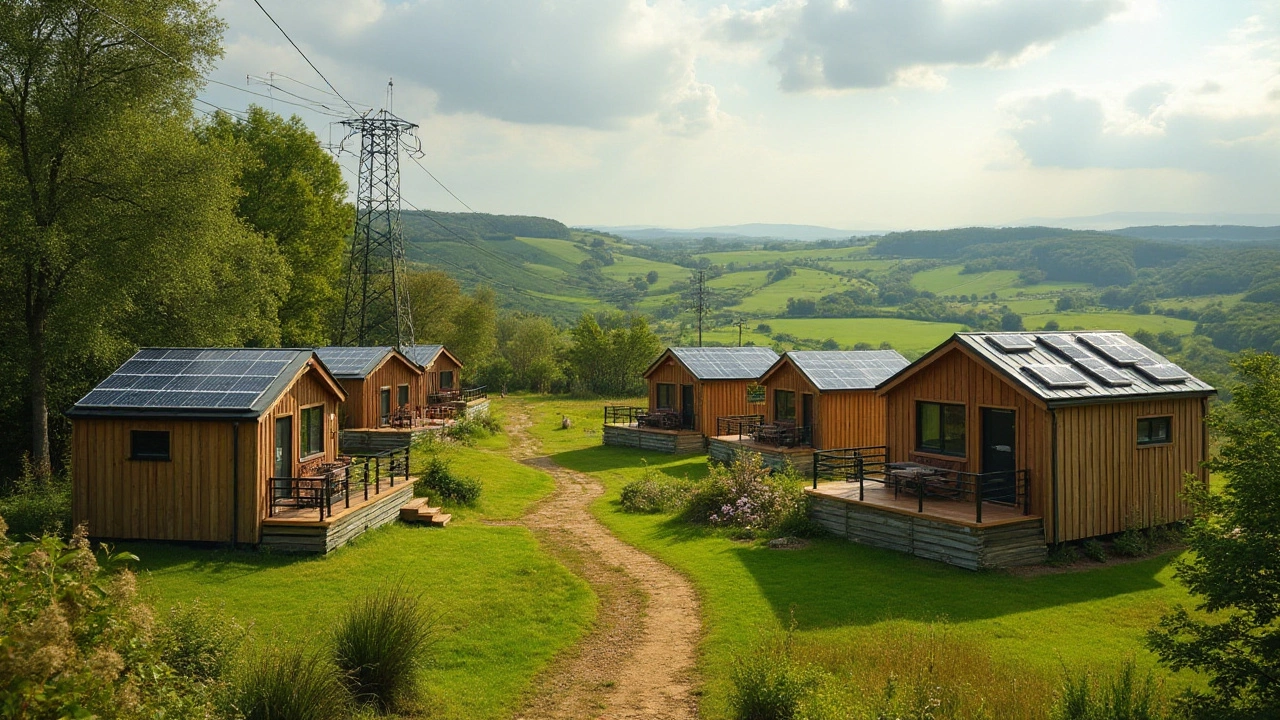Glamping, or glamorous camping, has rapidly emerged as a popular trend for travelers craving the comfort of modern amenities amidst the wonders of nature. Eco-friendly cottages, a recent addition to this trend, beautifully blend sustainability with a touch of luxury.
Amidst the towering trees and open skies, one might wonder about the power behind the cozy lights and heated rooms. Is electricity a given when glamping, or are there alternative sources that blend with the natural surroundings? As you embark on your glamping journey, unravel the intriguing mix of technology and nature, rooted in sustainable practices.
- Understanding Glamping and Eco-Friendly Cottages
- Electricity Sources in Glamping Sites
- The Role of Renewable Energy
- Tips for Sustainable Glamping
Understanding Glamping and Eco-Friendly Cottages
Once synonymous with roughing it out in the wild, camping has evolved significantly over the years. The concept of glamping merges the authenticity of the outdoor experience with the comfort of modern-day living. Instead of pitching tents near bug-friendly zones, glampers find themselves nestled in aesthetically designed tents, yurts, and eco-friendly cottages. These structures provide all the comforts of home—think plush bedding, running water, and yes, often even electricity. It's a luxurious twist for those who love being close to nature but aren’t keen on leaving their creature comforts behind.
On the eco-friendly spectrum, glamping takes a significant step towards minimizing the ecological footprint. Eco-friendly cottages are paramount for those seeking sustainability without sacrificing comfort. These accommodations often use renewable materials for construction, integrate solar panels, and employ rainwater harvesting systems. This commitment not only respects the surrounding environment but also offers a green alternative to traditional camping or holidaying methods.
As John Stuart, an environmental architect stated, "The goal is not to escape reality but to make it sustainable." His words resonate deeply with the ethos behind eco-friendly accommodation choices.
It's fascinating to note that the global glamping market is expected to reach unprecedented growth in the coming years. According to a study released by Grand View Research, the market is projected to grow at a compound annual growth rate of 13.9% between 2020 and 2027. This surge illustrates a growing interest in nature retreats that cater to luxury and eco-consciousness. Many travelers today wish to witness breathtaking vistas while ensuring their trips don't harm the Earth. Eco-friendly cottages align beautifully with these aspirations, featuring innovative eco-technologies that minimize energy consumption and promote sustainability.

Electricity Sources in Glamping Sites
When it comes to glamping electricity, the options are as varied as the landscapes where these idyllic retreats are set. Traditional electric grids might power the familiar comforts such as well-lit cabins or heating units, but many glamping sites have creatively embraced alternative and sustainable travel energy sources. Solar panels are amongst the most popular choices today, reflecting a commitment to environmental stewardship while still providing reliable energy. In many sun-drenched locales, photovoltaic panels efficiently convert sunlight into electricity, reaching peak performance during sunny days and storing excess energy in batteries for cloudy or night use.
Another exciting innovation is the use of micro-hydroelectric systems, particularly in sites adjacent to flowing streams or rivers. These systems harness the kinetic energy of moving water to generate power, ensuring a continuous electricity supply that aligns harmoniously with nature. Yet, in places where wind features prominently, wind turbines might find their place, spinning gracefully to produce energy. This rich tapestry of energy solutions allows glamping sites to reduce their carbon footprint significantly. A fascinating case is a remote glamping site located in the Scottish Highlands, which reported a reduction in grid dependency by over 40% after installing a combination of solar and hydroelectric systems.
For sites aiming to completely disconnect from traditional power sources, off-grid technologies enable achieving that ideal. Innovative battery solutions, engineered to store energy efficiently, make going off-grid a reality. With advancements in battery capacity and efficiency, guests at these sites still enjoy essentials such as lighting, charging stations, and even heated showers, all while being serenely off the grid. These sustainable energy solutions not only appeal to the environmentally conscious but also offer resilience in remote locations where conventional power might falter. "Embracing renewable energy is not just an ecological choice; it also enhances reliability," remarks environmental engineer Dr. Lisa Murray, who has studied alternative energy impacts extensively.
These sites often supplement their electricity use with other eco-friendly practices. Energy-efficient appliances, LED lighting, and smart energy management systems lower overall consumption without compromising on comfort. Glamping enthusiasts can also contribute by embracing the ethos of conservation, such as unplugging unused devices and relying on the natural light filtering through the tent walls during the day. Whether you're a first-time glamper or a seasoned traveler, knowing what power options your chosen site offers not only makes for a smoother stay but also supports the burgeoning eco-friendly travel movement that seeks to leave minimal trace on our planet.

The Role of Renewable Energy
When it comes to glamping in eco-friendly cottages, renewable energy plays a pivotal role in ensuring comfort intertwined with sustainability. Over the years, renewable energy sources like solar, wind, and hydro have become prevalent in luxury outdoor accommodations. The essence of such an approach is to minimize carbon footprints while maximizing the unique experiences that nature has to offer. Solar panels, often discreetly placed, harness the sun's energy to provide basic functions like lighting and charging points. Wind turbines, though used less frequently, offer a reliable alternative when designed well and placed in areas with sufficient wind flow. Hydroelectric systems might be the most enchanting; there's something uniquely poetic about using flowing water to light up the night sky around a glamping site.
Interestingly, the installation of these renewable energy technologies often mimics nature's effortless beauty, with designs that blend seamlessly into the landscape. This juxtaposition of technology and the natural environment invites travelers to engage in sustainable practices more thoughtfully. A study even highlighted that travelers are drawn to eco-friendly options, feeling an inherent connection to initiatives that support environmental conservation. For glamping site owners, renewable energy not only reduces long-term costs but also aligns with a growing demand for sustainable tourism options worldwide.
The International Renewable Energy Agency states, "Renewable energy is central to achieving the economic, environmental, and social objectives of sustainable development."
While traditional camping might require cooking over open fires and sleeping under mere canvases, glamping indulges in a little luxury while pioneering sustainable ways to enjoy the great outdoors. Many glamping sites operate off-grid, utilizing sophisticated battery systems to store surplus energy. This stored energy can provide a backup source, ensuring glampers never lack the necessary comforts, regardless of the time of day. The commitment to renewable energy fosters a connection with nature that is profoundly rejuvenating, sparking curiosity and respect in equal measure. This approach serves not just the planet but also enriches the travelers’ experience, transporting them into a world where indulgence meets harmony.
To illustrate the progression and implementation of renewable energy in the glamping world, consider how some sites have adjusted to using bio-digesters. These devices convert organic waste into methane gas, which can then be used as a cooking fuel, thereby closing the loop in sustainable energy usage. This method exemplifies how glamping, in its quest for opulence and sustainability, often leads the innovation front in renewable technology adaptation. Such steps are more than mere branding tools; they are transformative measures that encourage mindful tourism for a better tomorrow. Ultimately, the role of renewable energy in glamping is integral, not just to power the cottages, but to power a movement where luxury embraces and enhances environmental stewardship.

Tips for Sustainable Glamping
Embracing a sustainable approach while glamping not only protects the environment but also enhances your overall vacation experience. The choices you make during your stay can significantly minimize your carbon footprint. Start by selecting an eco-friendly site that uses renewable energy sources like solar or wind power to generate electricity. Many glamping sites are now equipped with solar panels to provide necessary power without harming the environment. If the site offers a renewable energy option, such as a hybrid installation incorporating battery storage, this can further reduce reliance on traditional grids.
When it comes to daily living, simple practices can go a long way in maintaining sustainability. Energy-efficient appliances, although sometimes an overlooked aspect of glamping, are vital. Check whether the cottage uses LED lighting and energy star-rated devices. This not only conserves electricity but also supports a more earth-friendly ethos. Remember to unplug devices when not in use to avoid energy wastage, as electronics on standby mode can still consume power.
"Preserving our environment is not just a mission; it's a journey that glamping facilitates without leaving behind the comfort," says eco-tourism expert Maria Sanchez.
Naturally, sustaining local flora and fauna should be prioritized. Many glamping sites now use eco-friendly materials in their construction and maintain habitats that support wildlife. Taking part in activities provided by your hosts, like guided nature walks, can broaden your understanding of biodiversity and conservation efforts. Respect all designated paths and be mindful of waste, ensuring you do not disrupt the natural order. Disposal of waste through composting or recycling improves environmental impact, contributing to a cleaner and greener planet. Sustainable travel cultivates a greater appreciation for the breathtaking surroundings you're immersed in.
Beyond energy use, consider water conservation. Water-wise practices not only conserve a valuable resource but also significantly enhance sustainability. Use water sparingly and stick to short showers. If toilets have dual-flush options, utilize them based on necessity. Many eco-friendly cottages incorporate rainwater harvesting systems which maximize efficiency and minimize waste. Checking for responsible water usage during your stay reinforces environmentally-conscious habits. And don't forget to bring along eco-friendly toiletries and cleaning supplies to reduce chemical runoff into local waterways.
Lastly, when glamping at an off-grid camping site, prepare for a more rustic experience. Although it may require some adjustments, such experiences enrich one's connection to nature. Pack solar-powered chargers for gadgets and a personal water purification kit. As you relish the joy of a digital detox, take advantage of the surroundings to reconnect with loved ones or delve into introspection. Consider sustainable cooking options like a solar cooker or a portable camp stove powered by biofuel. This promotes clean and efficient meal preparation, embodying the perfect harmony between technology and nature.
With glamping, the journey transcends a mere retreat. It's about cultivating a harmonious relationship with our planet. By following these tips, you're not only immersing yourself in natural beauty and tranquility but ensuring the same wonders are preserved for future generations. As you embrace the glamping lifestyle, remember that every small action contributes to a larger positive impact, enriching both your experience and the environment.
